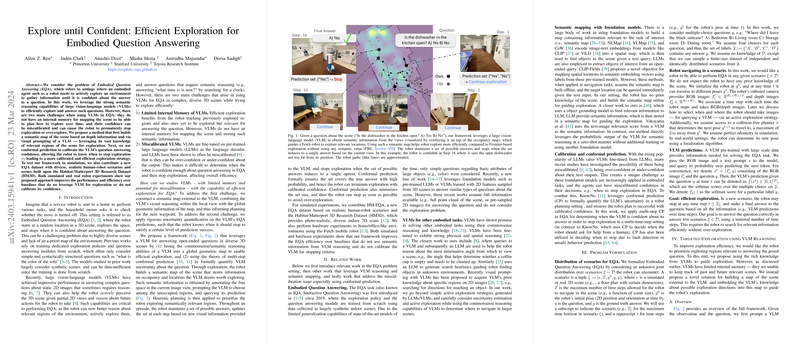Efficient Exploration for Embodied Question Answering through Conformal Vision-LLMing
Introduction
Embodied Question Answering (EQA) tasks a robot with discerning spatial and visual cues in an environment to answer a posed question. Traditional approaches have their exploration and question-answering capabilities built from scratch, limiting efficiency and generalizability across diverse settings. The integration of Vision-LLMs (VLMs) introduces strong semantic reasoning but accompanies challenges such as limited internal memory for effective scene mapping and exploration planning, alongside potential miscalibration in confidence estimation.
This paper introduces a structured methodology leveraging VLMs for enhanced EQA performance. By creating a semantic map external to the VLM, based on visual cues and depth information, and applying calibrated measures to evaluate the model's question-answering confidence, the proposed framework promotes efficient exploration strategies and accurate, confident answers to complex questions.
Challenges in Leveraging VLMs for EQA
Two primary challenges are outlined:
- Limited Internal Memory: VLMs lack an inherent mechanism to retain or map semantic information from the environment over time, hindering efficient exploration strategy development.
- Miscalibrated Confidence: VLMs often exhibit over- or under-confidence in their predictive modeling due to inherited miscalibration from underlying LLMs, affecting the robot's understanding of when sufficient information has been gathered to construct an answer.
Methodologies for Efficient Exploration
The framework introduced addresses these challenges through two main components:
- Semantic Mapping with Visual Prompting: Constructs an external semantic map by amalgamating depth information and visual cues from VLM, utilizing visual prompting to signify areas worth exploring. This, in effect, bridges the gap caused by VLM's limited memory, allowing for strategic planning and targeted exploration based on semantically rich regions.
- Calibrated Confidence with Conformal Prediction: Implements a measure to rigorously calibrate the confidence of the VLM's predictive capabilities using conformal prediction. This step ensures the robot can adequately assess when it has acquired enough information to confidently answer the posed question, thus, mitigating the issue of premature cessation or unnecessary prolongation of exploration.
Empirical Validation
To validate the framework, a bespoke EQA dataset (HM-EQA) was developed over the Habitat-Matterport 3D Research Dataset (HM3D), featuring diverse, realistic scenarios for rigorous testing. The dataset encompasses complex, open-ended questions requiring semantic reasoning. Comparisons against baseline models devoid of semantic reasoning or confidence calibration revealed the proposed method's superior performance in both simulated and real-world settings. By leveraging calibrated VLM insights for exploration and decision-making, the framework notably improved answer accuracy and exploration efficiency.
Implications and Future Directions
The introduced methodology exemplifies the potential of integrating calibrated VLM reasoning within robotic exploration tasks, particularly EQA. This not only enhances exploration efficiency but also paves the way for more nuanced interaction between robots and their environments, grounded in semantic understanding and calibrated confidence.
Future developments could explore dynamic adjustment of exploration strategies based on real-time feedback, integrating multimodal sensors for richer environmental understanding, and further refining confidence calibration techniques to adapt to evolving VLM capabilities. Moreover, expanding the framework to encompass a broader range of EQA contexts will be vital in solidifying its utility across various application domains.
In conclusion, the paper presents a significant step toward realizing efficient, VLM-driven exploration for embodied question answering, marking a convergence between semantic reasoning and rigorous statistical calibration to navigate the intricate challenges posed by complex, diverse environments.
